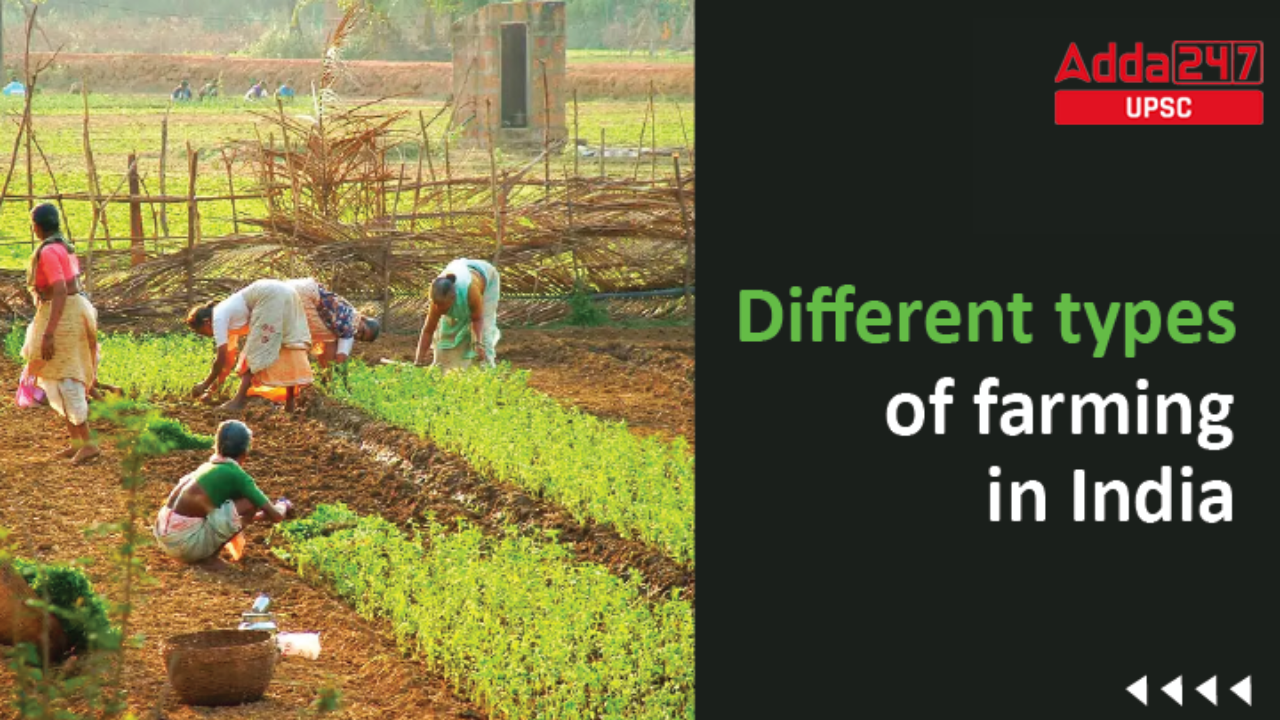Table of Contents
Different Types of Farming in India
Today, India has the 2nd highest crop output in the world. Different types of farming systems are followed in India, according to the locations where they are most suitable. The farming systems that majorly contribute to the agriculture sector in India are subsistence farming, organic farming, and commercial farming. Due to India’s geographical location, certain parts experience different climates, thus affecting each region’s agricultural productivity differently.
Factors influencing farming practices in India
- Nature of land,
- Climatic characteristics, and
- Available irrigational facilities.
Different types of farming in India
Candidates can check here different types of Farming in India:
Shifting Agriculture
- In this type of agriculture, a piece of forest land is cleared by cutting trees and burning of trunks and branches.
- After the land is cleared, crops are grown for two to three years and then the land is abandoned as the fertility of the soil decreases.
- The farmers then move to new areas and the process is repeated.
- This is practiced in most parts of India, especially North East Region.
Subsistence Agriculture
- In subsistence agriculture, the farmer and his family produce crops for themselves only or for the local market.
- This type of farming is characterized by small and scattered land holdings and the use of primitive tools.
- As the farmers are poor, they could not use fertilizers and high yielding variety of seeds in their fields that could increase their productivity.
Intensive Farming
- Intensive farming aims at maximum possible production on the limited farms with all efforts possible under the given circumstances.
- In this type of farming, farmers are capable of raising more than one crop a year, and huge capital and human labour is employed on every hectare of land.
- It is practiced in most parts of densely populated areas of our country.
Extensive Farming
- Extensive farming is the modern system of farming done on large farms also known as mechanical farming due to the extensive use of machines.
- The extensive farm raises only one crop a year and employment of labor and capital per hectare of land is comparatively less than the intensive farming.
Plantation Agriculture
- In plantation agriculture, bush or tree farming is done in huge areas.
- This type of farming is capital centered and needs good managerial ability, technical knowledge, improved machinery, fertilizers, and irrigation and transport facilities, among others.
- It can be distinguished from other farming as a particular or single-sown crop like rubber, tea, coconut, coffee, cocoa, spices, and fruit crops, etc. is sown and the yield is generally obtained continuously for a number of years.
- Plantation agriculture is export-oriented agriculture where the focus is more on the marketing ability of the crop.
- Most of the crops grown in plantation agriculture have a life cycle of more than two years.
- It is practiced in Kerala, Karnataka, Assam, and Maharashtra.
Commercial Agriculture
- Commercial Agriculture is practiced to raise crops on a large scale with a view to exporting them to other countries and increasing the foreign reserve of the country.
- This type of farming is done mostly in sparsely populated areas.
- It is mainly practiced in Gujarat, Punjab, Haryana, and Maharashtra.
- Examples: Wheat, cotton, sugarcane, corn, etc.
Dry Land Farming
- Dry farming or dry-land farming may be defined as a practice of growing crops without irrigation in areas that receive an annual rainfall of 750 mm – 500 mm or even less.
- It is practiced in low rainfall areas or where there is an inadequate irrigation facility.
- In this type of farming, moisture is maintained by raising special types of crops.
- Gram, jowar, bajra, and peas are such crops that need less water.
- Dryland farming is practiced in dry areas of the country such as western, north-western India and central India.
Wet Land Farming
- Wetland farming depends mainly upon rain, so it is practiced in high-rainfall or well-irrigated areas.
- In this type of farming, the major crops are rice, jute, and sugarcane.
- This type of farming is prevalent in the north, north-eastern India and on the slopes of the Western Ghats.
Terrace Agriculture
- In terrace agriculture, hill, and mountain slopes are cut to form terraces, and the land is used in the same way as in permanent agriculture.
- Due to scarcity of the availability of flat land, terraces are made to provide small patches of level land.
- It is also an effective way to check soil erosion due to terrace formation on hill slopes.



 TSPSC Group 1 Question Paper 2024, Downl...
TSPSC Group 1 Question Paper 2024, Downl...
 TSPSC Group 1 Answer key 2024 Out, Downl...
TSPSC Group 1 Answer key 2024 Out, Downl...
 UPSC Prelims 2024 Question Paper, Downlo...
UPSC Prelims 2024 Question Paper, Downlo...





